
Chapter 6 -- DUST STORMS OF MARS
INTRODUCTION
It was Ray Bradbury who wrote of the Sand Ships of Mars in his science fiction novel, The Martian Chronicles (Bradbury, 1946). One can imagine the fictional inhabitants of Mars trekking across its deserts in their floating machines stirring up huge dust devils. This great science fiction story set the stage for this author’s interest in Mars and who now writes about similar accounts of the real dusty whirlwinds of Mars.
For those observers who for the first time venture out under the sky to view the Red Planet will no doubt at first recoil back from the eyepiece in disbelief and bewilderment -- Mars observing is observing on the fast track. Mars is a difficult object of study for telescopic observers to be sure and suffice it to say it is not for the impatient person. Even experienced observers realize the difficulty in their quest to gaze upon The Red Planet. Old hands will begin early in the apparition to sharpen up their skill and again develop the acute eye necessary for seeing the faint details of Mars. Yes, we have to warm up, start practice slow and easy -- then really get on with it as the planet increases in apparent size.
One of the most spectacular events to watch in the Solar System is the development of a major Martian dust storm. From our vantage point on Earth a Martian dust cloud may seem to be just a nuisance to any would-be explorer on that planet. However, if you consider the actual size of these clouds then you suddenly realize that many of them would cover entire western United States! Imagine if a Mars-sized planet-encircling dust storm would occur on Earth; it would blank out most of an entire Hemisphere!
IDENTIFYING DUST ACTIVITY ON MARS
The ALPO Mars Section has used for its
criteria for identifying and cataloging dust clouds of Mars as
adopted from Leonard J. Martin's size classification for
Martian dust storms. One can categorize them as follows: A
local storm is one whose major axis does not exceed
2000 Km; a regional storm exceeds 2000 Km in at
least one dimension but does not encircle the planet; and an
encircling storm spans the circumference of Mars,
usually covering both hemispheres. A global storm
is an encircling event that covers the entire planet, including
the poles [Beish and Parker, 1990] [Martin
and Zurek, 1993].
To estimate the size of a dust storm one may
consider that one degree is 59.275 Km (36.832 miles) per degree;
so given the dark feature of Sirenum Mare is ~40 degrees long
that results in an area of 40 x 59.275 = 2,371-Km and would be
considered a "regional" storm, where as Solis Lacus is
~20 degrees resulting in an area of 1,186-Km or a
"local" storm.
Identifying the places where dust storms
begin and following their subsequent spread is most important to
future Mars exploration missions. The following criteria apply in
the diagnosis of Martian dust clouds:
I. Movement with obscuration of previously well-defined albedo features. Absence of this criterion disqualifies a candidate from inclusion under the dust clouds category.Contrary to what some would-be Mars experts claim, that after dust storms the dust settles quickly to the surface and reduces contrast of albedo features, dust remains in the atmosphere of Mars for weeks -- at times for months -- before settling to the surface [Pollack , 1989], [Kahn, 1992]. These dust particles are very fine grains of volcanic ash and when raised aloft by these storms they reach heights of several kilometers. At those altitudes the planetary wind system carried the dust around the upper atmosphere and the weak gravity of Mars just will not cause them to settle quickly. Also, much of the dust provides the nuclei for CO2 ad H2O ice to produce cloud formations and it stays in the upper wind system for months [Lee, 1985]. A dusty atmosphere is the real cause of the loss in contrast of surface features, not because it settles onto those features [Kahn, 1992].II. Bright appearance of these phenomena in red light. In the past, astronomers have identified Martian dust clouds and/or obscuration as "yellow clouds." It is incorrect to describe the color of Martian dust clouds as " yellow ." While they may appear yellowish when observed without the aid of color filters, they are brighter in red and orange light than they are in yellow light. Dust clouds brighten faintly in yellow filters and display well-defined boundaries through orange and red filters. During the initial stages of formation, they often appear very bright in violet and ultraviolet light, suggesting the presence of ice crystals. We vigorously discourage the use of the term "yellow clouds" to describe dust. If a suspect cloud is not bright in red light, it is not to be considered a dust cloud.
III. A bright, yellowish-red haze over the polar regions is another indicator of possible dust activity somewhere on the globe of Mars. Dust streaks within the polar hood or adjacent to the polar cap edge may indicate dust clouds in the polar region. A dust cloud within the polar region will be red in color so it will be brighter in red light, and the cap will be bright as well. In green light this same streak will appear darker (green compliments red light) and will indicate a dust streak.
WHAT CAUSES DUST CLOUDS ON MARS?
As local dust traps sunlight heat builds up in the atmosphere [Kahn, 1992]. The warmer air flows to cooler regions where it generates local winds and raises the delicate particles of Martian dust. Regional clouds spread continuously [Houben, 1981], [Zurek, 1989]. However, a major dust storm often progresses through the quickening of activity at a number of additional cores. This appears to represent a classic example of a non-linear response -- true catastrophic phenomena, where only a small change in circumstances, such as an increase in the solar radiation from the Sun, can produce a huge shift [Sheehan, 2003].
Writing in the May 1972 Sky and Telescope magazine, Charles F. ("Chick") Capen gives us a clue in; "There is a remarkable similarity between the storms of 1956 and 1971. Before each one the Martian atmosphere displayed little or no white-cloud activity, and there was high contrast between familiar surface markings. Just before the storm’s onset, the limb showed a light-yellow brightening. Both events began suddenly, within a single rotation of the planet, as a brilliant white streak over the Hellespontus-Noachis region. Their initial dimensions and shapes were alike, though the 1971 cloud was always bigger and brighter." [Capen, 1972]. The appearance of a sudden limb arc may be an indicator of an unreported dust storm in progress.
"The hypothesis that dust storms can be expected on Mars near the time of perihelion and southern summer solstice (Antoniadi, 1930; Capen, 1971) has become so well accepted that the prediction of such an event for 1973 (Capen and Martin, 1972) not only went unchallenged, but its occurrence was taken for granted by many."
Illustrations prepared by Carlos Hernandez, former ALPO Mars Recorder, of dust devils, a dust storm on Mars moving across it's surface, and the theory of the formation of dust devils and storms.

Dust devils increase in number and size then may develop into large dust storms.
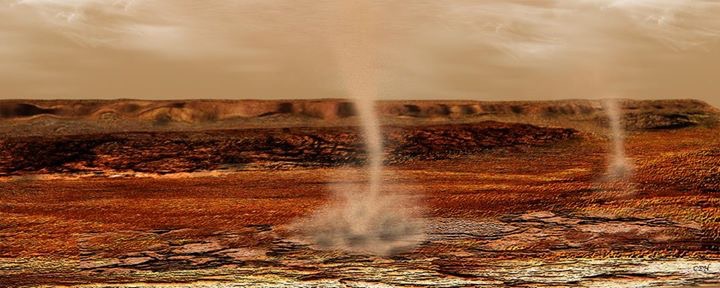

Theory of the formation of dust devils and dust clouds.


ARE DUST STORMS PREDICTABLE?
Recent surveys, including our Martian meteorology study, have shown that dust events can occur during virtually any season [Martin and Zurek, 1993] [Beish and Parker, 1990]. Classically, the storms occurring during southern summer (270° - 359° Ls) are larger and more dramatic, and can even grow rapidly to enshroud the whole planet. Planetary researchers refer to these massive dust storms as "planet-encircling" storms that usually occur around 315° Ls. It should be remembered, however, that these global dust storms are quite rare only ten have been reported since 1873, and all but two have occurred since 1956.
While predicting these events is nearly impossible to do, our studies show that the Martian dusty season indicates that the number of dust clouds is more often observed from mid-southern summer, between 241° and 270° Ls, with a peak period at 255° Ls. In the past, many of the major dust events occurred during the same seasonal period and led some researchers to refer to these major dust storms as "precursor storms prior to planet-encircling events." When a major dust event does occur during this period then we find that the highest probability of predicting planet-encircling dust storms occurs during mid-southern summer at or near 315° Ls [Beish, 1999].
A recent survey by professional researchers shows that dust events can occur during virtually any season [Martin and Zurek, 1993]. Their paper reinforces our study for a main peak period for dust events is 285° Ls (just after southern summer solstice) and a secondary peak has been observed in early northern summer, around 105° Ls. Their paper articulates our hypnosis that dust storms occurring during southern summer are larger and more dramatic. Local dust storms can even grow rapidly to enshroud the whole planet. A secondary peak at around 105° Ls has also been observed in early northern summer (90° - 179° Ls).
An exception to this was the 2001 planet-encircling storm that occurred at around 185 degrees Ls or 65 degrees before perihelion. This was the earliest major storm on record, and it surprised us because is started nearly two Martian "months" before the observed dusty "season" and four "months" before the high probability period of 315° Ls [Parker, 2001].
We have sense dismissed the notion that Mars has a dust storm season; however, it is clear from all the evidence over the past 32 years, 1971 through mid-2003, that observers expected to see some dust activity when Mars is near perihelion. Major dust obscuration have been recorded on Mars within +/- 65 degrees of perihelion time and we must all be aware of this possibility in the next three months.
The Great Planet-Encircling Dust of 2001: An unusual planet-encircling dust storm was observed during the 2001 apparition of Mars and can be best described in the following Internet locations:
The 2001 global dust storm began on June 24, 2001 (183.5° Ls) in NW Hellas and major dust cloud activity ended on August 02, 2001 (206.4° Ls) while the atmosphere of Mars remained dusty for at least a month thereafter.Also, the British Astronomical Society Mars web page: http://www.britastro.org/mars/ then read the two PDF files by Richard McKim:
The opposition of Mars, 2001, Part I: http://alpo-j.sakura.ne.jp/JBAA119123-143McKim.pdf
and The opposition of Mars, 2001: Part II: https://britastro.org/node/11532
Dust streaks have been seen in northwest of the Hellas Basin across Serpentis-Noachis (320° W, 30° S), or in the "Eye of Mars" (the Solis Lacus region; 90° W, 30° S), or perhaps in 1988 within the Chryse Basin (40° W, 10° N), the last because dust clouds were reported in Chryse during the two apparitions prior to 1986, in 1982 and 1984. The discovery of new dust cloud sensitive areographic locations is most important to future Martian exploration missions. To detect dust clouds, use red, yellow, and magenta filters.
There are numerous reports of anomalous transient albedo features appearing near dust clouds, especially when the solar phase angle was reasonably large. When these clouds reach heights of several kilometers, they may cast shadows that are observable from Earth. Dr. Richard McKim (BAA) has written an excellent review of Martian dust storms [McKim, 1996].
Hubble Space Telescope (HST) press release "Seasonal dates of great martian dust storms (1894-1982)," describes when dust storms occur on Mars: https://www.spacetelescope.org/images/opo0131l/. and there is evidence that dust storm may effect atmospheric pressure on Mars can be found in this study: http://www-k12.atmos.washington.edu/k12/resources/mars_data-information/data.html At Viking Lander-2 the pressure peaked at 9.57 mB on October 05, 1977 at 1722 UT (Ls 344.5°) and again at 9.42 mB on October 05, 1977 at 1411 UT (Ls 344.5°). Then at Viking Lander-1 the pressure peaked at 10.72 mB on June 09, 1982 at 2219 UT (Ls 138.7°) and again at 10.72 mB on June 15, 1982 at 0021 UT (Ls 141.3°).

NOTE: Viking-1 was launched on August 20, 1975 and began orbiting Mars on June 19, 1976 (9m 29d) and the Lander-1 landed in the Chryse Planitia (22.3°, 312.1°) on July 20, 1976 (Ls 96.8°) and lasted until November 11, 1982 (Ls 225.3°). Viking-2 was launched on September 09, 1975 and began orbiting Mars on August 07, 1976 (10m 26d). Lander-2 landed in Utopia Planitia (47.6°, 134.3°) on September 03, 1976 (Ls 117.2°) and lasted until April 12, 1980 (Ls 91.5°).
PAST DUST STORMS SEEN ON MARS
During the favorable Perihelic opposition of Mars in September 1877 (opposition occurred on September 5, 1877 at 260° Ls), Giovanni Schiaparelli noticed a large, bright cloud east of Solis Lacus. Soon albedo features began to vanish from the region and we now speculate that Schiparelli had witnessed the beginning of a dust storm that, by December 1877, had covered much of the planet with dust.
Dr. Richard McKim, Director of the Mars Section of the British Astronomical Association (BAA), performed an exhaustive historical study of Martian dust storms and has concluded that there have been only ten planet-encircling events reported since 1873. These took place in 1909, 1924, 1956, 1971, 1973, 1975, 1977 (2 storms), 1982, and 2001. Of these, only the 1971 storm was considered truly "global." The 1956 and 1971 storms originated in the Hellespontus-Noachis deserts. The 1973 and 1977 storms originated in the sands of Solis Lacus. And the 2001 storm flared up in Hellas. While dust storms can form rapidly, the largest can take weeks, even months, to disperse.
Since 1971, the year of the "Great Dust Storm of Mars," the ALPO Mars Recorders have suspected that these disturbances came in pairs. We have seen that in 1971 a major dust storm occurred on 213° Ls, followed by a "planet encircling" dust storm on 259° Ls. Again, in 1973 a major storm began on 244° Ls and was followed by a "planet encircling" storm on 300° Ls and [Martin, 1974]. The Viking Lander recorded two "planet encircling" storms on 204° and 268° [Tillman, 1988].
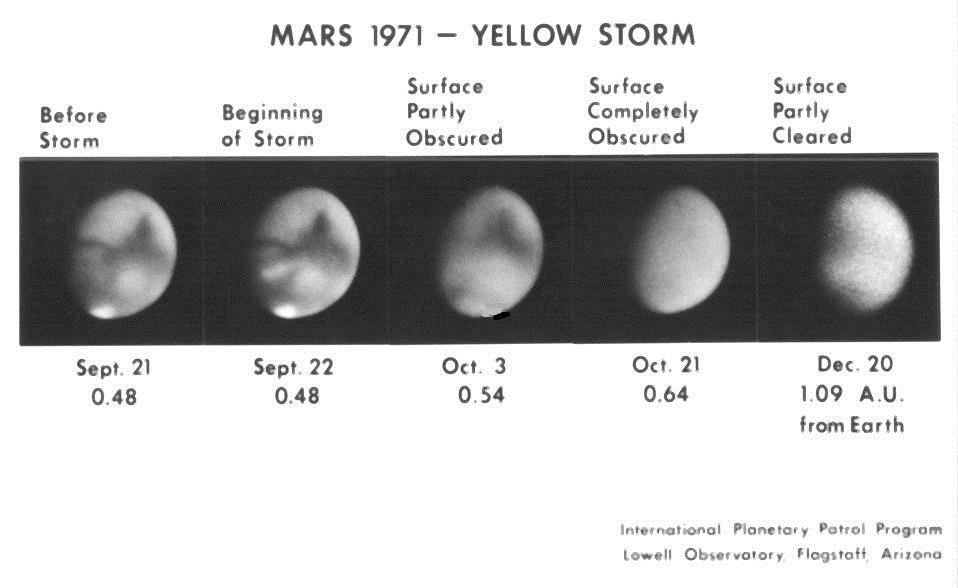
Figure 6-1. A sequence of photographs of the Great Dust Storm of 1971 composed by C. F. Capen. The "before storm" image was taken on Sept 21 (259° Ls). Dust clouds in Hellas and westward on Sept 22 (260° Ls), spreading in both directions by Oct 3 (267° Ls), Oct 21 (278° Ls), and begins to dissipate by Dec 20 (314° Ls). Hellas is light oval area south of Syrtis Major. Photographs taken by Lowell Observatory.
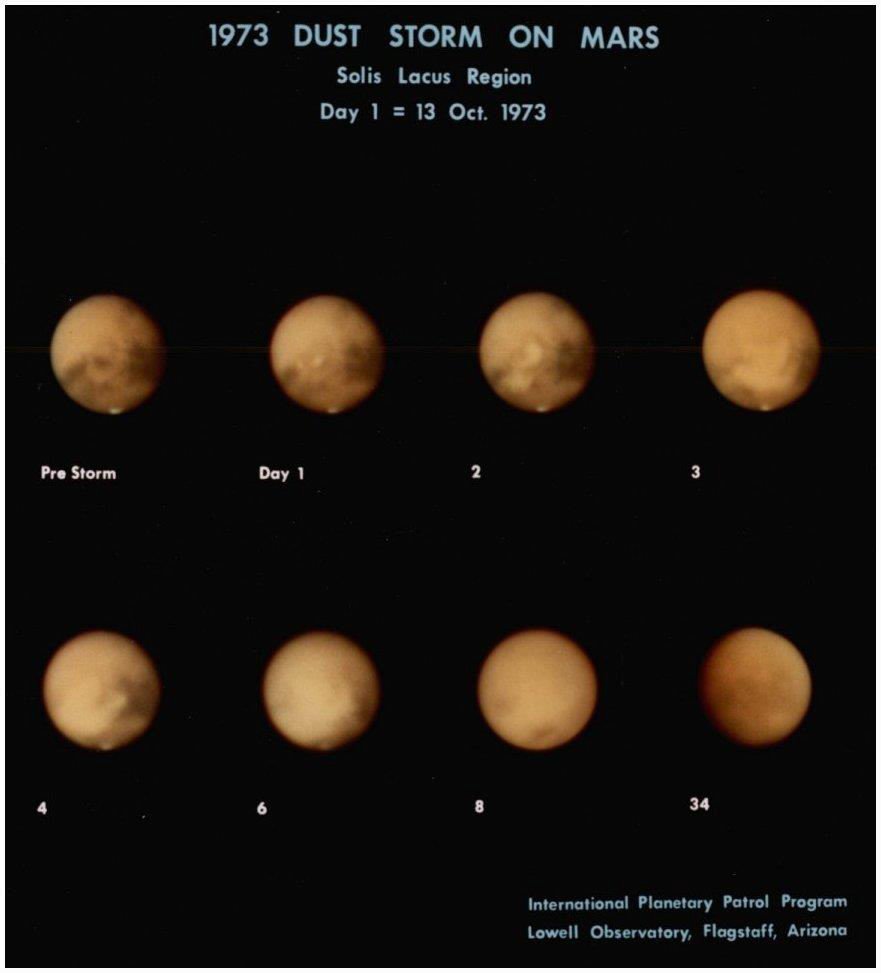
Figure 6-2. A sequence of photographs of the Great Dust Storm of 1973 composed by C. F. Capen. The "pre storm" image was taken Oct 13 (300° Ls). Bright dust cloud in Solis Lacus during "Day 1" on Oct 14 (301° Ls), increasing in size and a second dust cloud appears south of Solis Lacus in "Day 2" on Oct 15 (301° Ls), both dust clouds spread east and northeast in "Day 3" on Oct 16 (302° Ls), nearly blanks out 1/3rd of visible disk in "Day 4" on Oct 17 (302° Ls). In "Day 6" on Oct 19 (304° Ls) the dust storm is spreading north, east and west. Dust storm raging over much of the planet in "Day 8" on Oct 21 (305° Ls). "Day 34" on November 10, 1973 Mars begins to clear of planet-encircling dust storm for 1973. Hellas is light oval area south of Syrtis Major. Photographs taken by Lowell Observatory
Although the two dust storms of 1988 did not
reach the "planet encircling" stage, similar patterns
emerged; during 206° Ls a major storm occurred, followed by
another major storm on 313° Ls [Beish and Parker, 1988] and [Beish and Parker, 1989]. Perhaps the statistical
significance of the three periods above appear to mislead us when
attempting to predict when these disturbances should occur.
However, one should be especially alert when observing Mars
during these times -- even though we have not passed through the
first sensitive period as of yet, be watchful in the next few
weeks, alas, a major dust storm may be lurking just around the
corner!
DUST CLOUDS IN THE POLAR REGIONS
The bright, yellowish red haze over the polar regions is another indicator of possible dust activity somewhere on the globe of Mars. Dust streaks within the polar hood or adjacent to the polar cap edge may indicate dust clouds in the polar region. Dust clouds at periphery of the cap are quite common and often appear as bright white areas near the polar cap. If there are dust particles present then the white area, such as the polar regions, will brighten in red light as well.
When viewing or imaging the polar region with color filters one must be careful use a green and then a red filter to determine the color of any extraneous dark streaks that may be present. A dust streak crossing the cap may not be easily recognizable if a red filter is used exclusively. Remember, that the dust on Mars is red in color so it will be brighter in red light; however, the polar cap will appear bright in red light as well. In green light this same streak will appear darker (green compliments red light), so the observers will be confident that a dust streak may be there.
Early in the 1997 apparition, at 11° Ls, images from the HST (See Figure 6-3) and from Parker (CCD) revealed dust streaks crossing the NPC [Parker, 1999].
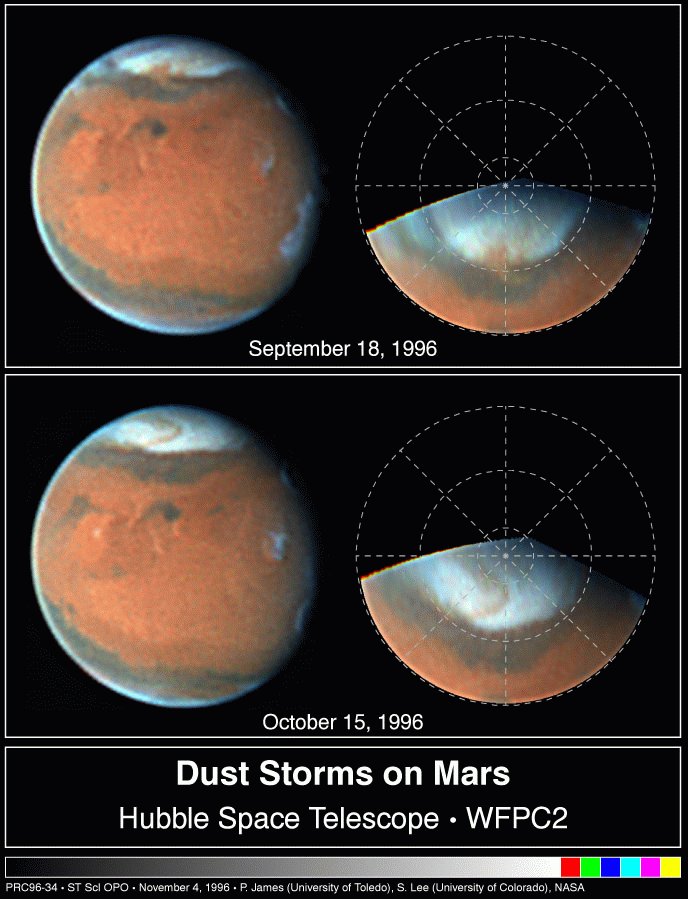
Other than this polar dust event, ground-based observers did not report any definite dust cloud activity during the apparition. There were sporadic reports of brightening in Chryse, but these are fairly normal for the season and exhibited no characteristics of significant dust events. Chryse has been very bright at times in red light since the early 1980’s. At least some of this brightening may be due to evening and morning clouds injected with dust. The dust devil activity observed by the Pathfinder [Schofield et al., 1997] may be at least a partial source of this dust.Figure 6-3. Dust cloud/streak in north polar cap (NPC) of Mars as imaged by the Hubble Space Telescope on September 18 and October 15, 1996.
Ground based telescopes were busy at work in 1999 when it caught a huge cyclone in the northern polar region. HST imaged this storm the next day (See Figure 6-4).
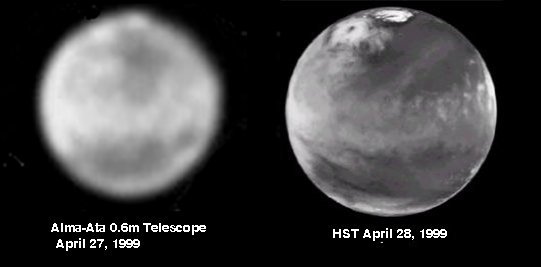
Figure 6-4. A cyclone disturbance near the north polar cap of Mars was discovered by the Alma-Ata 0.6-meter ground-based telescope on April 27, 1999 (130.1° Ls) and imaged by the Hubble Space Telescope the following day (April 28). Along the edge of the polar cap, cyclonic disturbances are common during the late summer and fall. This storm system is located at the edge of the northern polar cap.
Figure 6-5. Image-1, from Malin Space Science Systems titled "Mars Orbiter Camera Mars Weather Update for Solar Conjunction 2002" shows a massive dust storm probably riding on a cold wave from the north polar region of Mars during the first week in August 2002 (51° Ls) .Image-2, North Polar Dust Storm. Another dust cloud rages over Uchronia-Utipia (Borealis) during March 7, 2003 (148° Ls). Image MGS MOC Release No. MOC2-334, 18 April 2003 (170.1° Ls). Image-3,May Dust Storm in Acidalia: MGS MOC Release No. MOC2-374, 28 May 2003 (192.7° Ls), Northern Acidalia Planitia was engulfed in a continent-sized dust storm in mid-May 2003. This composite of Mars Global Surveyor (MGS) Mars Orbiter Camera (MOC) daily global images shows the early autumn dust storm (top 1/4 of the picture) sweeping east-northeast (toward upper right) across the northern plains. Dust storms like these are common in early autumn and generally last about a day or two. This simple cylindrical view of Mars covers regions from eastern Kasei Valles/northeast Tempe Terra (in the upper left), to central Arabia Terra (center right), Argyre Basin (lower left), Noachis Terra (lower right), and the northern edge of the retreating south polar seasonal frost cap (bottom). Sunlight illuminates the scene from the left.Figure 6-5a. LEFT: Dust clouds cross north polar cap on January 29, 2010 (44.3° Ls, Damian Peach). CENTER: Dust clouds cross north polar cap later on January 29, 2010 (Pete Edwards). RIGHT: Dust clouds cross north polar cap on January 30, 2010 (Pete Lawrence).
DUST STORMS IN THE USUAL PLACES
A few "local" and "regional" dust storms have temporarily altered familiar dark markings by hiding sections of them from view; however, a more violent and electrifying event has been seen that can have catastrophic effects on our Red Planet. These rare events we call a "planet-encircling" dust storm that engulfs an entire hemisphere of Mars, at times invading much of the north and south of Mars. These great dust storms have obscured all but the tallest peaks of the huge volcanoes and mountain ranges of Mars from view. What is interesting about these events is that great dust storms on Mars seem to come in pairs, with the first storm being a major (though not global) event and the second storm being a planet-encircling one (see Figure 6-6 through 6-7).
Figure 6-6. As the dust began to clear from the Martian sky during the Great Dust Storm of 2001 the high volcanoes of the Tharsis region on Mars began to pop put from the tops of the dusty haze. The left image taken by Ed Grafton (205.2° Ls, C14) shows four Tharsis volcanoes poking up through the dust veil. Center image by Maurizio Di Sciullo (10"Newt) shows same features and right image by Don Parker (16" Newt) demonstrates that some of the volcanoes on Mars can be seen from Earth at least in certain circumstances. Abbreviations: Ar = Arsia Mons, P = Pavonis Mons, As = Ascraeus Mons and O = Olympus Mons.
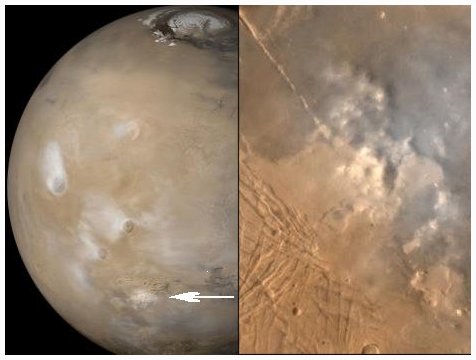
Figure 6-7. Dust Storm in Syria. MGS MOC Release No. MOC2-366, 20 May 2003 (188.1° Ls). A dust storm rages in Syria Planum, south of the Labyrinthus Noctis troughs (at lower center) in this Mars Global Surveyor (MGS) Mars Orbiter Camera (MOC) composite of daily global images taken during the recent southern winter. In this view, water ice clouds are present over each of the five largest Tharsis volcanoes, Olympus Mons (right center), Alba Patera (upper center), Ascraeus Mons (near center), Pavonis Mons (toward lower left), and Arsia Mons (lower left). The summertime north polar residual water ice cap can be seen at the top of this picture. Sunlight illuminates the planet from the left

Figure 6-8. Seven images of the same dust cloud moving around in the Syria-Claritas region near Solis Lacus. 1) Teruaki Kumamori, 21 May 2003 1929 UT (194.5° Ls CM 94° , 2) Eric Ng, 22 May 2003, 2112 UT 245.6° Ls , CM 110° , 3) M. Valimberti, 24 May 2003, 1711 UT, 190.4° Ls , CM 32° , 4) Tomio Akutsu, 24 May 2003 1815 UT 190.4° Ls , CM 47° , 5) Tan Wei Leong, 24 May 2003 2214 UT 190.4° Ls , CM 106° , 6) Eric Ng, 26 May 2003 2115 UT 191.6° Ls , CM 72°, and 7) Eric Ng, 30 May 2003, 2039 UT 193.9° Ls, CM 24°.
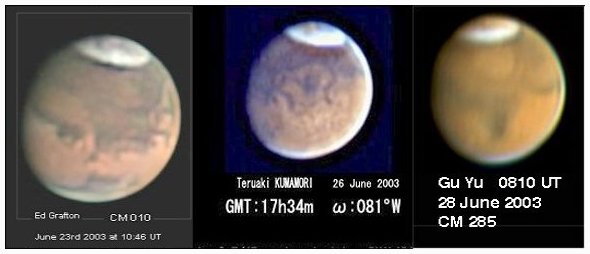
Figure 6-9. Three recent images of Mars showing what appears to be a dust swirl or cloud in the South Polar Cap (SPC). The yellow-brown anomaly appears to the center-left of the LEFTimage (208.2° Ls, Grafton) and CENTERimage (210° Ls, Kumamori) and more to the center in the RIGHTimage (211.3° Ls, Gu Yu). Notice the yellow-brown hollow in the SPC.
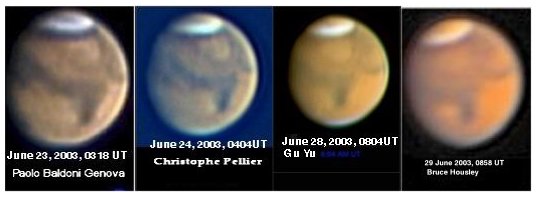
Figure 6-10. A sequence of photographs taken by amateur astronomers of the two dust cloud east of Syrtis Major in Isidis and Libya.
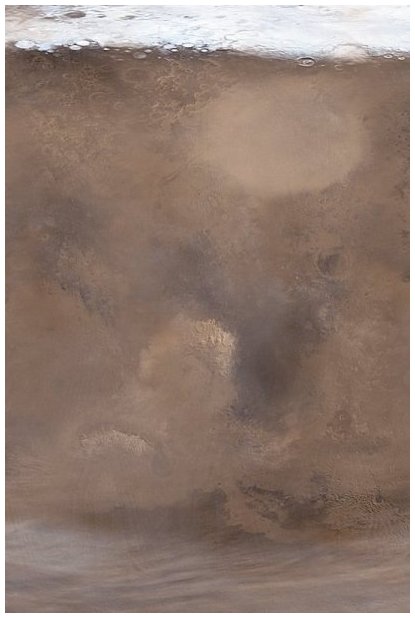
Figure 6-11. Two dust clouds during June 29, 2003 in Isidis Planita and Libya: MGS MOC Release No. MOC2-414, 7 July 2003 (216.8° Ls). This is the dusty time of year for Mars. The Mars Global Surveyor (MGS) Mars Orbiter Camera (MOC) team has been anticipating for months that late June through July 2003 will be a time of large dust storms and considerable haze. As June turned to July, several large dust storms began popping up. Two examples are shown here in this mosaic of MOC daily global images from June 29, 2003. Near the center of this picture is a large dust storm engulfing southern Isidis Planitia. Toward the upper right (northeast) of the Isidis storm is another event in northern Elysium Planitia. This view of a portion of Mars is illuminated by sunlight from the left. This is a simple cylindrical map projection, north is up. The large dark feature just left of center is Syrtis Major; the bright oval toward the bottom left is the giant Hellas impact basin, which is more than 2,000 km (more than 1200 miles) across. The white area at the bottom of the picture is the south polar seasonal frost cap, made up mostly of carbon dioxide. The wispy features at the top of the image are clouds over the martian northern plains.
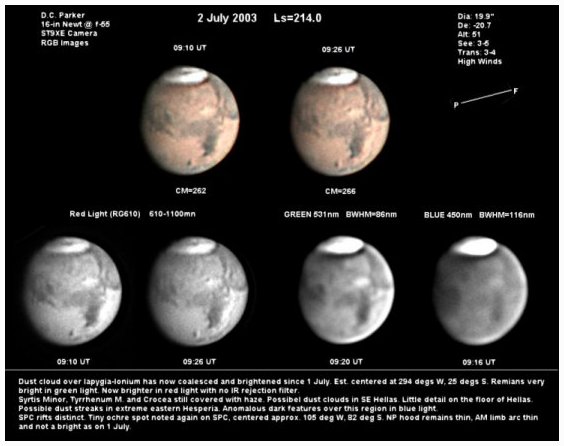
Figure 6-12. Mars images for 02 July 2003 (213.7° Ls) by DC Parker showing a dust swirl streak south of Syrtis Major in Pandorae Fretum and Iapygia Mare, and dust cloud in northwest Hellas. This appears to be the beginning of a major dust storm.

Figure 6-13 . Image-1 : Dave Moore 28 July 2003 (229.8° Ls) shows dusty cloud streak over Acidalium Mare, Achillis Pons and Niliacus Lacus. Image-2: Skip Waller shows this same streak on 29 July 2003 (230.5° Ls) apparently stalled out over Achillis Pons. Image-3: Ed Grafton took this 30 July 2003 (231.1° Ls)image with a bright dust cloud, shaped like a lazy "V" in Chryse and a somewhat clearer Achillis Pons and Niliacus Lacus. Image-4: : Again Ed Grafton imaged the dust cloud apparently spreading southeast into Aram and westward into Eos and Aurorae Sinus- Erythraeum Mare. Dust also appears to be obscuring Nilokeras on the morning limb.

Figure 6-14. Image-1 : Dave Moore’s 29 July 2003 shows dust cloud in Achillis Fons with dust streak over Achillis Pons and Niliacus Lacus. Image-2 : The dust cloud and streak on Dave Moore’s image on 29 July 2003 nearly an hour and a half later. Image-3: Dust cloud appears to have expanded into Chryse and Xanthe and spreading southeast over Oxia Pallus and southwest into Eos and Aurorae Sinus- Erythraeum Mare. Dust also appears to be obscuring Nilokeras on the morning limb.

Figure 6-15. Image-1 : Don Parker captures Chryse dust clouds on 31 July 2003.Image-2: Clay Sherrod imaged bright cores of dust clouds obscuring Chryse, Eos and Aurorae Sinus on 31 July 2003. Image-3: The other side of Mars as imaged by M. Valimberti shows dust over Eos and Aurorae Sinus and in Chryse on 31 July 2003. Image-4: T. Kumamori imaged similar dust activity in Eos and Aurorae Sinus, Chryse-Xanthe on 31 July 2003.

Figure 6-16. August 01, 2003 Wes Higgins (LEFT) and Thomas Williamson (RIGHT) imaged continuation of dust cloud movement and obscuration in Aram, Chryse-Xanthe, Eos and Aurorae Sinus and obscuring parts of Erythraeum Mare.
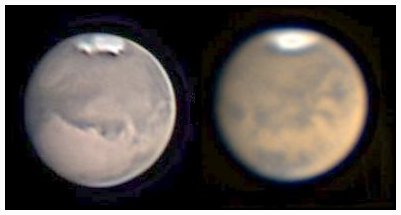
Figure 6-17. August 02, 2003 Skip Waller (LEFT) and Stefan Buda (RIGHT) imaged dust clouds in Eos and Aurorae Sinus as they diminished in size and intensity.
THE 2007 MAJOR DUST STORMThe 2007 apparition of Mars has just barely started when a major dust storm has been imaged by several expert Mars observers as Mars is far away from Earth with an apparent diameter of only 6.2 seconds of arc. Some may say "oh no, not again; another dusty Mars to hide its surface from our cameras!" Another exciting dust event apparently has started in the late weeks of June 2007 and continues a month later with the latest images posted on July 27. What will Barsoom do next!!!!
This article is under construction and more dusty Mars reports will no doubt be forth coming. Please stand by because if this storm encircles the entire north and south of Mars we may see it subside in the next week or so. We have seen his before and coined the phrase, "precursor dust event" to the "big one" that usually follows the first storm around 75 degrees Ls or a terrestrial month later. So, by mid-September 2007 we should expect to see the "big one" -- if Mars follows our rules.
Figure 6-34. Images of dust storm during the early 2007 apparition of Mars. First images of dust storm during the early 2007 apparition of Mars. Bright dust cloud in Noachis-Pandorae on 2007-06-24 by David Moore (USA). Following the next day, 2007-06-25, Jim Melka (USA) imaged the dust cloud appears to have moved a little westward and south. Then on 2007-06-26 the dust cloud grows and expands west and south as imaged by E. Lomeli (USA).
Figure 6-35. Following the next day, 2007-06-27, Larry Owens (USA) and Jim Melka imaged the dust cloud that appears to have expanded westward and to the southeast.
Figure 6-36. Sample Dust Storm Images, 07 July - 26 July 2007 (272° - 284° Ls). IMAGE-1: 2007-07-07; Jim Melka (186° CM) , IMAGE-2: 2007-07-08; Damian Peach (72.5° CM), IMAGE-3: 2007-07-09; Damian Peach (71.4° CM) , IMAGE-4: 2007-07-11; Don Parker (126° CM), IMAGE-5: 2007-07-13; Don Parker (104° CM), IMAGE-6: 2007-07-17; Don Parker (70° CM), IMAGE-7: 2007-07-18; Damian Peach (336.4° CM) , IMAGE-8: 2007-07-19; Don Parker (49° CM) , IMAGE-9: 2007-07-21; Don Parker (30° CM), IMAGE-10: 2007-07-25; Jim Melka (12° CM), IMAGE-11: 2007-07-25; Don Parker (354° CM) , IMAGE-12: 2007-07-26; Sean Walker (322° CM) .
* Revision: Also, several interesting dust events that may correlate with ground-based observations are recorded on the Malin Space Science Systems Home Page in a "Series of Storms Shrouds Mars in Dust, Captioned Image Release No. MSSS-3” 19 & 20 July 2007 (http://www.msss.com/msss_images/2007/07/19/index.html).
Figure 6-37. It’s triplets! All there Tharsis volcanoes peak out from the dust layer. LEFT: Dave Tyler’s 11 August image taken at the same UT as CENTER: Ed Grafton’s images that reveals Tharsis Montes. RIGHT: Larry Owen’s image on August 22 (300° Ls).When this dust storm ended is as always hard to determine; apparently major dust clouds were not seen past the first week of August 2007. The dusty atmosphere continues to reduce surface during the first week of September, but appears to be clearing. The Tharsis volcanoes peeked out from the dust around August 11 (293° Ls) and the dark hollows of the huge mountains could still be seen on August 22.Figure 6-38. Apparent secular feature change caused by dust storm: Meridiani Sinus is separating from Sabaeus Sinus.* Revision: On August 5 and August 09, two storms were observed west of Elysium Mons. One large storm developed in the same area on August 9. These dust storms dissipated after only one day.
(See: http://www.msss.com/msss_images/2008/08/13/)
Figure 6-39. Short lived dust storms west of Elysium Mons on August 5 and August 09, 2008 (108.2° - 110.1° Ls), image from Malin Space Science Systems Home Page.
The 2018 Apparition Dust StormsWhile observers were surprised by the planet-encircling storm that occurred in 2001 at around 184 degrees Ls or 66 degrees before perihelion, the 2018 apparition supplied us with a similar but more extensive spectacle with a global dust storm. Discovered by Efrain Morales Rivera (Aguadilla, Puerto Rico) using LX200ACF 12" telescope his May 31, 2018 (184.9° Ls ) at 0731UT image establishes the beginning as he captured a bright spot, in red and IR light, in Mare Acidarium-Niliacus Lacus. Several observers, John Boudreau and Joseph Rueck, followed with more evidence of a large dust cloud that divided and spread southward into eastern Chryse and Xanthe
Figure 6-42. First images of the 2018 global dust storm: Image-1: Efrain Morales Rivera, 2018-05-31, 0731UT, Ls=184.9°, CM=338.0°. Image-2: John Boudreau, 2018-05-31, 0852UT, Ls=184.9°, CM=357.7°. Image-3: Joseph Rueck, Ls=184.9°, CM=13.1°. Image-4: Efrain Morales Rivera, 2018-06-01, 0924UT, Ls=185.6°, CM=356.1°.Soon the dust clouds expanded westward into Tharsis and encircled the globe of Mars across Syrtis Major and into Aeria-Moab and back to Chryse during early June. Several prominent areas on Mars are completely covered with dust, such as Meridiani Sinus, Margaritifer Sinus, Chryse, much of Niliacus Lacus and Aurorae Sinus - Agathodaemon - Ophir.
Figure 6-43. Three images from June 2 through June 7, 2018 by Isamu Hirabayashi shows dust clouds encircling the equatorial zone of Mars.This will be a brief report of the 2018 global dust storm and more will follow as ALPO sorts out more reports and images. Apparently this storm was global because the entire globe, including both polar caps, was covered with a thick vial of dust by late-June and the storm may have peaked sometime on or about June 22, 2018. A dusty haze covered the entire planet throughout July, August and September 2018.
Following the excellent work by the Association of Lunar and Planetary Observers in Japan (ALPO-Japan) in their graphic charts of the dust storm progress: May 31, 2018 - June 22, 2018 for each image:
DiscussionMars observers have longed for a away to predict conditions that leads to the onset of dust storms. Since dust storms probably occur each year around the time of the summer solstice in the southern hemisphere we safely predicted the development of another dust storm, in the Hellas-Noachis region, in July of 2003. This would be the first storm during the Martian southern spring and is what some refer to as the "precursor" storm that leads to the development of a second storm sometime later in the Mars year. This event did in fact occur on July 1, 2003.
Records of observations of Mars indicate that dust storms occur around the time of southern Summer Solstice (270° Ls), soon after perihelion passage (250° Ls); however, the global dust storms in 2001 and 2018 occurred earlier than expected and started on the same Martian dates of June 24, 2001 (183.5° Ls ) and May 31, 2018 (184.9° Ls ). During the two Perihelic apparitions prior to 1986 (i.e. 1971 and 1973), as initial dust cloud was sighted in the Serpentis-Noachis (335° W, 35° S) region on September 21, 1971, having developed overnight, and another one appeared in morning light next to Solis Lacus (90° W, 30° S) on October 12, 1973. Each bright cloud soon evolved to obscure the entire Martian global persisted for several months. When a great dust storm has reached maturity, Mars’ disk appears bright orange and few, if any, surface features can be identified.
Also, as seen in Figures 6-3 through 6-5 above showing a dust swirl in the North Polar Cap (NPC) we also may have seen a similar dust swirl in the SPC, shown in Figure 6-9. Just this morning, 01 July 2003 at 0840" 1000 UT, two observers, Beish and Parker, have noticed what appears to be possible dust clouds south of Syrtis Major. Normally dark features from 270° W" 310° W, 15° S - 20° S appears to have changed dramatically since 30 June 2003 and is brighter now in orange (W23A filter) and blue-green (W64 filter) light. Areographic northwest Hellas (305° W, 20° S) brighter with a light spot that was not there on 30 June 2003. Light/bright streak from Pandorae Fretum into Iapygia Mare. Also, Tyrrhenum Mare, Cimmerium Mare lighter than on 30 June 2003 and Hesperia not as well-defined. While Zea Lacus was seen by Beish the "canal" Peneus that connects from Yoanis Fr. to Zea Lacus was gone on 01 July 2003.
A few "local" and "regional" dust storms have temporarily altered familiar dark markings by hiding sections of them from view; however, a more violent and electrifying event has been seen that can have catastrophic effects on our Red Planet. These rare events we call a "planet-encircling" dust storm that engulfs an entire hemisphere of Mars, at times invading much of the north and south of Mars. These great dust storms have obscured all but the tallest peaks of the huge volcanoes and mountain ranges of Mars from view. What is interesting about these events is that great dust storms on Mars seem to come in pairs, with the first storm being a major (not global) event and the second storm being a planet-encircling one. See the Revised List of Dust Storms on Mars.
References
Antoniadi, E.M. (1930). La Planete Mars 1659-1929, pp. 39-47. Herman et Cie, Paris, France.
Beish, J.D., Parker, DC, Eicher, D. (1988), "Dust Storms Observed On Mars," Astronomy Magazine, Vol. 16, No. 9, September.
Beish, J.D., Parker, D.C., and Hernandez, C.E., (1989,) "The Red Planet Shows Off", Sky and Telescope Magazine, Vol. 77, No. 1, pp. 30-35, January.
Beish, J.D., and D.C. Parker (1990). "Meteorological Survey of Mars, 1968-1985," Journal of Geophysical Research , Vol. 95, B9, pp. 14567-14675. August 20.
Beish, J.D. (1999), "Meteorological Survey of Mars For Opposition Years 1965 - 1995," The ALPO Computing section , November.
Bradbury, Ray, (1950), The Martian Chronicles, Chapter November 2005: The Off Season, pp. 132,“ 143, Doubleday, Bantam Books, 1985.
Capen and Martin (1972), "Mars' Great Storm of 1971," Sky and Telescope Magazine, Vol. 41, No. 2, May.
Capen and Martin (1972), "Survey of Martian Yellow Storms," Bulletin of the American Astronomical Society, Vol. 4, No. 3, Part III, March.
Houben, Howard, "A Global Martian Dust Storm Model," Proceedings; Third International Colloquium on Mars , Pasadena, CA August 331 "“ September 2, 1981, pp117.
Kahn, R.A., T.Z. Martin, R.W. Zurek, and S.W. Lee (1992), "Chapter 29: The Martian Dust Cycle," Mars , U.of AZ Press, pp. 1017-1024
Kahn, R.A., T.Z. Martin, R.W. Zurek, and S.W. Lee (1992), "Chapter 29: The Martian Dust Cycle," Mars, U.of AZ Press, pp. 1028-1029.
Kahn, R.A., T.Z. Martin, R.W. Zurek, and S.W. Lee (1992), "Chapter 29: The Martian Dust Cycle," Mars , U.of AZ Press, pp. 1040-1044
Lee, S.W. (1985), "Influence of Atmospheric Dust Loading and Water Vapor Content on settling Velocities of Martian Dust/Ice Grains," MECA Workshop on Dust on Mars II, LPI Tech. Report 85-02 , pp 51-52.
Martin, L.J. (1974), "The Major Dust Storms of 1971 and 1973," ICARUS , 23, 108-115.
Martin, L.J., P. B. James, and R. W. Zurek, (1991), "MIGHT IT BE POSSIBLE TO PREDICT THE ONSET OF MAJOR MARTIAN DUST STORMS?" https://ntrs.nasa.go...19940028709.pdf
Martin, L. J. and R. W. Zurek (1993). "An Analysis of the History of Dust Activity on Mars." Journal of Geophysical Research, Vol. 98, no. E2, pp. 3221-3246.
McKim, R. (1996). "The dust storms of Mars." Journal of the British Astronomical Association, Vol. 106, no. 4, pp. 185-200.
Pollack, J.B. (1989), "The General Circulation of the Martian Atmosphere," Proceedings; Fourth International Colloquium on Mars, Tucson, AZ, January 10-13, pp. 48.
Parker, D.C., J.D. Beish, D. M. Troiani, D. P. Joyce, and C. E. Hernandez (1999), "Telescopic Observations of Mars, 1996-1997: Results of the Marswatch Program," ICARUS , Vol. 138, No. 1, March, P.3.
Parker, D.C. (2001), "The 2001 Martian Dust Storm," Sky and Telescope Magazine, Vol. 103, No. 6, December, pp. 117.
Schofield, J. T., J. R. Barnes, D. Crisp, R. M. Haberle, S. Larsen, J. A. Magalhaes, J. R. Murphy, A. Seiff, and G. Wilson 1997. The Mars Pathfinder atmospheric structure investigation/ meteorology (ASI/MET) experiment, Science, 278, 1752-1758.
Sheehan, William (2003), excerpts from article with collaborating ALPO Mars Section authors to be published in the near future.
Tillman, James E. (1988), "Mars Global Atmospheric Oscillations: Annually Synchronized, Transient Normal-Mode Oscillations and the Triggering of Global Dust Storms," Journal of Geophysical Research (JGR), Vol. 93, No. D8, pp. 9433-9451, August.
Tillman, James E. (1997), "Mars," July 04, 1997, http://www-k12.atmos.washington.edu/k12/resources/mars_data-information/data.html
Troiani, D.M., D.P. Joyce, D. C. Parker, C. E. Hernandez, and J.D. Beish (1997), "Telescopic Observations of Mars, 1996-1997: Results of the MarsWatch Program¾ I: Surface and Dust," SecondMars Telescopic Observations Workshop, Tucson, AZ, October 2-3.
Zurek, R. W. (1989) , "Dust in the Martian Atmosphere," Proceedings; Fourth International Colloquium on Mars , Tucson, AZ, January 10-13, pp. 57.